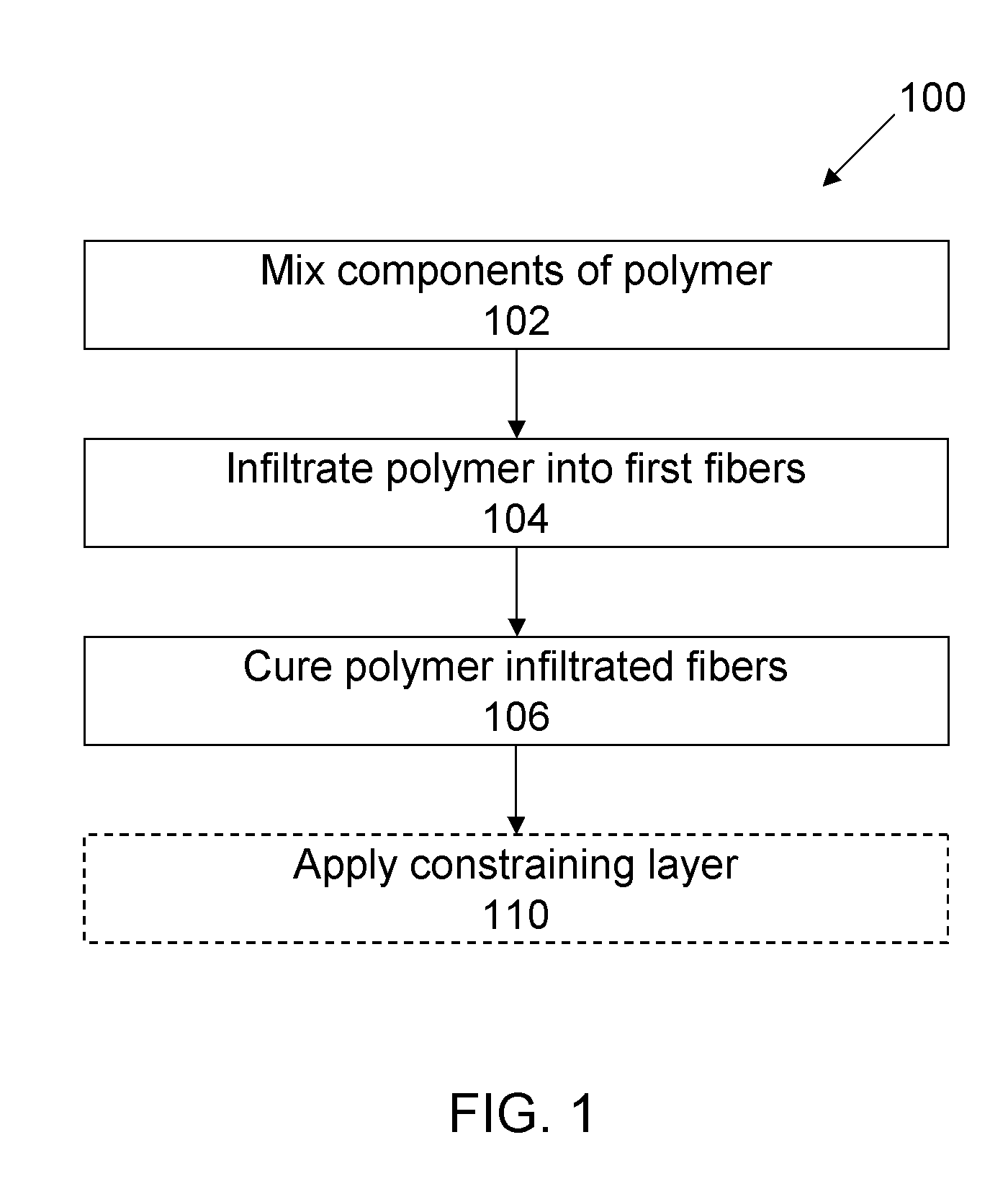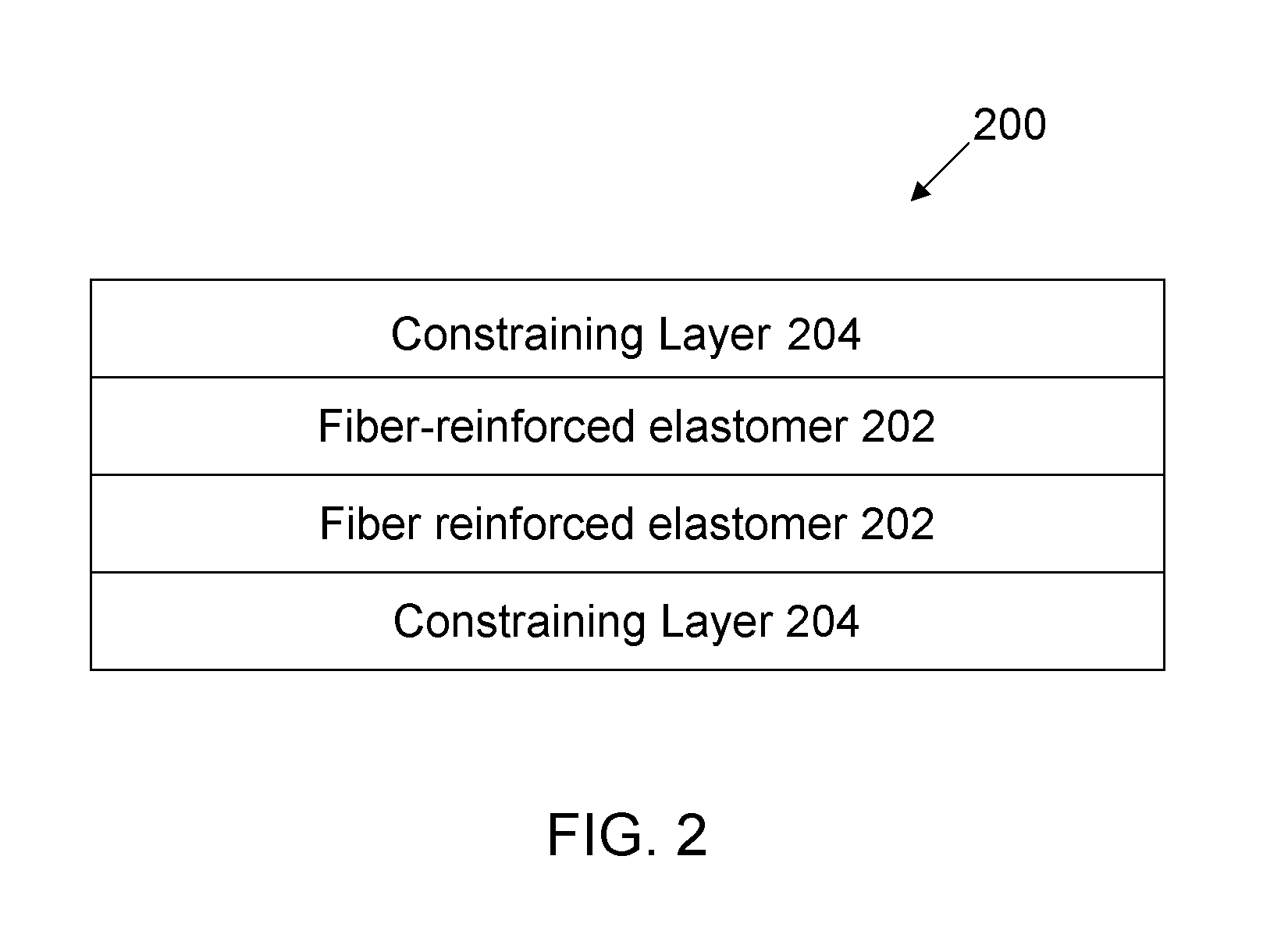Polymer composites possessing improved vibration damping
a polymer composite and vibration damping technology, applied in the field of vibration damping, can solve the problems of noise or motion associated with vibration that may distract and be uncomfortable for customers, and affect the operation of the vehicle, so as to increase the damping, increase the compliance, and control the effect of thermal expansion
- Summary
- Abstract
- Description
- Claims
- Application Information
AI Technical Summary
Benefits of technology
Problems solved by technology
Method used
Image
Examples
example 1
Effects of Fiber Reinforcement on Composite Damping Performance
[0099]The influence of the fiber configuration of the damping performance of the fiber-reinforced elastomer composites was investigated. FIG. 3 illustrates a plot of storage modulus and loss factor as a function of frequency for embodiments of the fiber-reinforced elastomer composites having carbon-fiber mats, 0° / 90° Innegra fibers, ±65° carbon-fiber plain weave, ±45° carbon-fiber plain weave, and ±28° carbon-fiber braid (with respect to the long axis of the composite), where the elastomer was polyurethane. A control elastomer, without reinforcement, was also tested for comparison.
[0100]The samples each possessed dimensions of about 3 mm thickness, about 10 mm width, and about 10 mm length. The fibers of the composites were oriented with respect to the long axis of the composite. The fiber volume fraction was about 50%.
[0101]As illustrated in FIG. 3, each of the composites exhibited a maximum loss factor greater than abo...
example 2
Dynamic Mechanical Analysis (DMA) of Composite and Damping Tile
[0103]Samples having dimensions of about 3.0 mm thickness, 10.0 mm width, and 9.5 mm length were examined using a Dynamic Mechanical Analyzer (DMA). A neat polyurethane elastomer (FIG. 4A) with no reinforcements was examined. A state-of-the-art damping tile (FIG. 4B) was examined. A composite with carbon fiber having a plain-weave configuration and a fiber orientation about ±65° in a volume fraction of about 50% (FIG. 4C) was examined. A composite with carbon fiber having a plain-weave configuration and a fiber orientation about ±45° in a volume fraction of about 50% (FIG. 4D) was examined. A composite with carbon fiber having a braid configuration and a fiber orientation about ±45° in a volume fraction of about 50% (FIG. 4E) was examined. A composite with carbon fiber having a plain-weave configuration and a fiber orientation about ±25° in a volume fraction of about 50% (FIG. 4F) was examined. A composite with carbon fi...
example 3
Modal Testing and Finite Element Analysis Validation of Dynamic Mechanical Analyzer Evaluation
[0107]Modal testing of the composite attached to aluminum beams was evaluated at frequencies from about 100 Hz to about 3000 Hz. One composite included 11 plies (about 0.1″ total thickness) of carbon fiber laminates, each having fibers oriented at about ±25° relative to the long axis of the composite. The viscoelastic composite was bonded between two aluminum beams having dimensions of about 17.75″×2.75″×0.25″ to provide shear deformation. To extend the measurement range, a second sandwich beam was constructed wherein the viscoelastic composite was bonded between two aluminum beams having dimensions about 3.75″×2.75″×0.25″. The temperature was maintained at about 23°.
[0108]The modal testing was evaluated using finite element analysis to calculate the resulting shear modulus G′ and loss factor. Finite element analysis was completed for both G13 and G23. The G13 calculations are equivalent to...
PUM
| Property | Measurement | Unit |
|---|---|---|
| dynamic shear modulus | aaaaa | aaaaa |
| Poisson's ratio | aaaaa | aaaaa |
| static Young's modulus | aaaaa | aaaaa |
Abstract
Description
Claims
Application Information
 Login to View More
Login to View More - R&D
- Intellectual Property
- Life Sciences
- Materials
- Tech Scout
- Unparalleled Data Quality
- Higher Quality Content
- 60% Fewer Hallucinations
Browse by: Latest US Patents, China's latest patents, Technical Efficacy Thesaurus, Application Domain, Technology Topic, Popular Technical Reports.
© 2025 PatSnap. All rights reserved.Legal|Privacy policy|Modern Slavery Act Transparency Statement|Sitemap|About US| Contact US: help@patsnap.com



